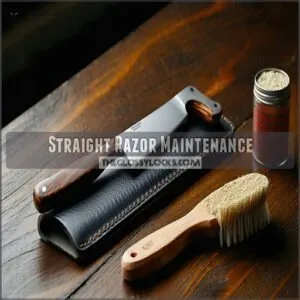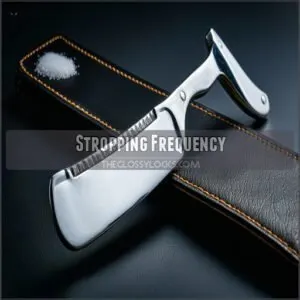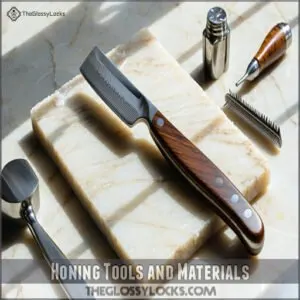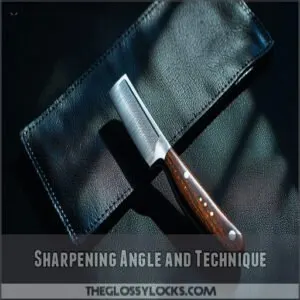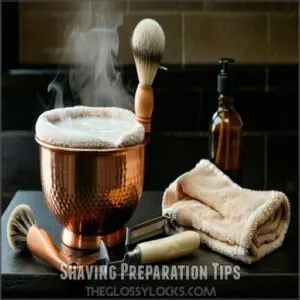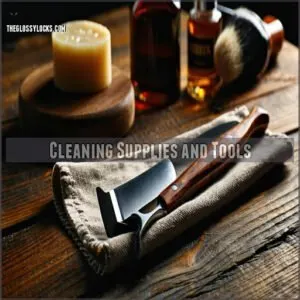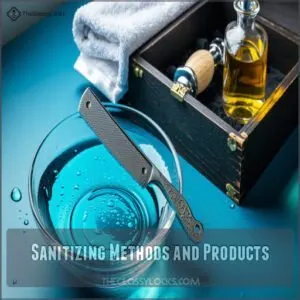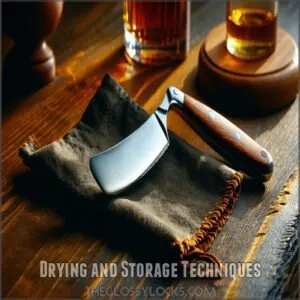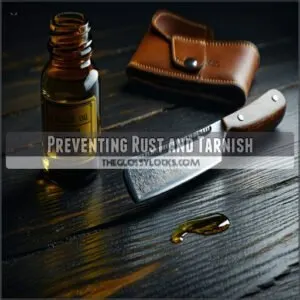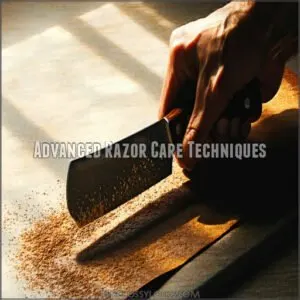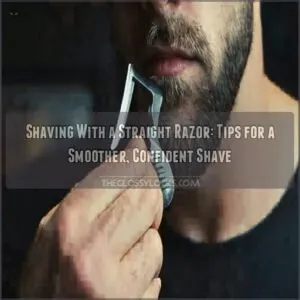This site is supported by our readers. We may earn a commission, at no cost to you, if you purchase through links.
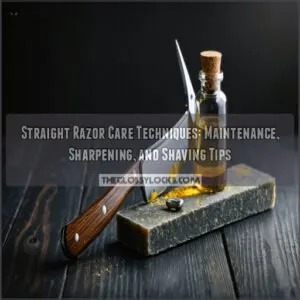
Clean the blade daily with warm water, mild soap, and a lint-free cloth, then dry it completely to prevent rust. For extra protection, apply a thin coat of oil before storing it in a dry place, like a leather pouch.
Hone the blade occasionally with a whetstone, keeping a steady 30-degree angle. A well-maintained razor isn’t just sharp—it’s the difference between a smooth shave and a bad day.
Table Of Contents
- Key Takeaways
- Straight Razor Maintenance
- Razor Sharpening Methods
- Shaving Preparation Tips
- Cleaning and Sanitizing Razors
- Advanced Razor Care Techniques
- Frequently Asked Questions (FAQs)
- How to properly take care of a straight razor?
- Do I need to oil my straight razor?
- How often do I need to hone my straight razor?
- Do you go against the grain when shaving with a straight razor?
- What causes straight razor handle wear?
- Can straight razors be used for body shaving?
- How to safely travel with a straight razor?
- Are custom razor modifications worth considering?
- What’s the lifespan of a straight razor?
- Conclusion
Key Takeaways
- Strop your razor daily before shaving to keep it sharp and aligned, using 20-50 light strokes on a leather strop.
- Dry your razor completely after every use and store it in a dry place to prevent rust and damage.
- Hone your razor every 3-6 months or when stropping doesn’t restore sharpness, maintaining a steady 30-degree angle.
- Apply a thin coat of blade oil weekly, especially in humid areas, to protect against rust and prolong its lifespan.
Straight Razor Maintenance
Taking care of your straight razor keeps it sharp, clean, and ready for each shave.
With simple steps like stropping, cleaning, and proper storage, you can protect your razor from dullness and rust.
Stropping Techniques
Straight razor stropping keeps your blade sharp and aligned. Use a leather strop or stropping belt to maintain edge precision.
You can buy a quality leather strop online. Proper strop tension guarantees effective blade realignment.
Follow these tips:
- Choose quality stropping tools like leather strops.
- Use minimal pressure to avoid damage.
- Maintain steady strop tension.
- Strop before shaving for razor alignment.
- Perform 20-50 strokes per session.
Honing Methods
To keep your straight razor shave-ready, occasional honing is necessary.
Use a honing stone, maintaining consistent razor angles to preserve edge geometry.
For peak sharpness, consider these straight razor maintenance tips.
Wet honing with a whetstone guarantees smooth, sharp results.
Push the blade gently, flip, and repeat.
| Honing Step | Tools Needed | Tips for Success |
|---|---|---|
| Wet the Stone | Whetstone | Use water for lubrication. |
| Maintain Blade Angle | Razor, Honing Stone | Stay around 30 degrees. |
| Flip and Push | Razor | Smooth, even strokes matter. |
Daily Cleaning Routine
After honing, focus on razor hygiene with a consistent daily care routine. Start by rinsing your blade with warm water, then dry it completely using a soft, lint-free cloth to prevent rust.
For thorough straight razor cleaning, use mild soap and sanitize with isopropyl alcohol.
Don’t forget handle maintenance—inspect pivot points and wipe them clean with appropriate cleaning supplies.
Storage and Safety Precautions
After cleaning, proper razor storage is key to razor upkeep. Use a dry location like a wooden box or leather pouch to shield against moisture.
Rust prevention is simple: dry your blade thoroughly before storing. For blade protection, apply a thin coat of oil.
Proper pre-shaving preparation is also essential for a smooth, comfortable shave. These razor care techniques guarantee safety and maintain sharpness, preserving your investment.
Razor Sharpening Methods
Keeping your straight razor sharp is essential for smooth, irritation-free shaves. Learn how to strop and hone properly to maintain the blade’s edge and keep it shaving-ready.
Stropping Frequency
How often should you strop? Before every shave is ideal.
Regular stropping keeps sharpness levels high, correcting blade alignment and extending razor durability.
It’s a vital part of straight razor care, reducing the need for honing. Learn more about proper stropping technique.
Consistent strop intervals maintain better blade maintenance and smooth shaves. Think of it as daily blade realignment for premium razor maintenance.
Honing Tools and Materials
A sharp edge starts with the right tools.
Honing stones, like water stones or diamond stones, refine your razor.
Use whetstones with grits between 1,000-12,000 for effective razor sharpening.
A straight razor honing guide is beneficial for beginners.
Pair lower grits to remove flaws and higher grits to polish.
The Norton 4k/8k waterstone is ideal for beginners, simplifying blade maintenance.
Consistent honing guarantees smooth shaves.
Sharpening Angle and Technique
To master straight razor sharpening, hold your razor with the spine leading and maintain the correct bevel angle—usually 15-20 degrees.
This preserves the razor geometry while ensuring edge alignment. Use minimal pressure on a high-quality strop material.
Flip the blade over its spine to avoid chipping.
Honing frequency varies, but stropping daily keeps the blade sharp longer.
Shaving Preparation Tips
Preparing your skin and tools properly sets the stage for a smoother, safer shave.
With the right products and technique, you can protect your skin and make each pass with your razor more effective.
Skin Preparation and Exfoliation
Getting a smooth shave starts with proper skin preparation. A basic preshave routine helps protect your skin and reduce irritation.
- Wash your face with a gentle cleanser to remove oil.
- Exfoliate to clear dead skin, preventing razor bumps.
- Massage your face with hot towel compresses to soften stubble.
- Address specific skin types or conditions with specialized products.
This routine is crucial for a comfortable shave, and by following these steps, you can achieve a closer shave with less irritation.
Shaving Cream and Oil Selection
Clean skin deserves quality products. Stick with natural shaving cream or shaving soap, like Mitchell’s Wool Fat for sensitive skin.
Use preshave oil for extra glide—sandalwood adds a luxe touch. Shaving oils and cream types matter; they cushion the blade and boost skin protection.
Don’t skip aftershave balms—they soothe your face and seal the deal.
Razor Handling and Angling
Hold your razor with a firm yet relaxed grip. Focus on maintaining a 30-degree blade angle for smooth, safe strokes. Let the razor’s balance guide your moves for steady control.
Understanding proper shaving techniques is essential for a successful shave. Use these tips:
- Keep a secure razor grip.
- Angle the blade at 30 degrees.
- Shave with the grain first.
- Control the handle, not pressure.
- Use short, precise strokes.
For more information, visit shaving techniques to master the art of shaving with confidence and achieve a smooth finish with short, precise strokes.
Shaving Against The Grain
Shaving against the grain delivers a close shave but risks skin irritation if done carelessly.
Start by mastering grain direction and use shallow shave angles.
Light razor pressure prevents cuts while ensuring razor safety.
For best results, shave with the grain first.
Follow up against the grain for stubborn stubble, ensuring smooth strokes.
| Technique | Benefit | Risk | Tip |
|---|---|---|---|
| Shave with the grain | Less irritation | Coarser stubble remains | Start with gentle, precise strokes |
| Shave against the grain | Closer shave | Skin irritation possible | Use light pressure and angles |
| Check grain direction | Reduces drag | Error causes nicks | Observe hair growth patterns |
| Maintain blade sharpness | Prevents pulling | Dull blades irritate skin | Regular stropping is essential |
Cleaning and Sanitizing Razors
Keeping your straight razor clean and sanitized prevents rust and guarantees safe shaves. Use the right tools and methods to maintain both hygiene and blade performance.
Cleaning Supplies and Tools
A clean straight razor prevents dullness and rust.
Use razor brushes and mild cleaning solutions to clear soap residue.
You can find a variety of straight razor cleaning products to aid in the process.
After rinsing, dry with a lint-free cloth and apply razor oil to protect the blade.
Keep shaving soap and strop materials clean for consistent razor care, and store in protective cases, maintaining razor cleaning as part of your shaving routine.
Sanitizing Methods and Products
Sanitizing razors is key to great razor care. Use sanitizing solutions like isopropyl alcohol or barbicide for bacterial control and disinfection.
Razor cleaners help avoid bacteria buildup; let blades soak briefly and dry thoroughly.
Anti-rust coatings protect against moisture damage. Stick to disinfectant options designed for metal to maintain sharpness and prevent rust, keeping your razor ready with great razor care.
Drying and Storage Techniques
After shaving, dry your razor thoroughly with a lint-free cloth to prevent rust. For daily storage, use a razor case or stand in a cool, dry spot.
Apply blade oil to the edge for added protection.
Extended storage? Opt for materials like leather pouches or wooden boxes. These straight razor storage solutions keep your blade safe and moisture-free.
Preventing Rust and Tarnish
To keep rust and tarnish at bay, always dry your razor thoroughly after each use.
Use blade oil for added metal protection, especially in humid areas.
Store it in a dry spot, away from moisture, and consider a leather pouch or wooden box for safe-keeping.
Daily care like wiping and oiling guarantees pristine razor maintenance.
Advanced Razor Care Techniques
When your razor needs more than basic care, it’s time to focus on advanced maintenance.
From professional sharpening to troubleshooting blade issues, these techniques guarantee your razor stays in top condition for years.
Professional Sharpening and Honing
Honing keeps your razor sharp and dependable. Professional sharpening guarantees consistent razor geometry and sharpness.
Follow these steps:
- Use honing tools like Naniwa stones for precise edge refining.
- Focus on proper sharpening techniques, keeping the blade flat against the honing stone.
- Strop afterward for blade realignment.
Send to experts every few months for flawless results!
Razor Inspection and Maintenance
Inspect your razor regularly to master straight razor maintenance. Check the razor edge for sharpness or nicks using arm hair or light stropping.
Look for rust or buildup on the blade and pivot handle. Clean with mild soap and dry thoroughly to prevent rust.
Tighten loose parts and oil the blade for lasting razor care and performance.
Troubleshooting Common Issues
Problems with straight razors? Address common issues like rust, dull edges, or loose handles quickly to protect your razor.
For maximum safety and performance, review best practices for razor blade handling.
- Rust Removal: Use blade oil and a lint-free cloth to scrub gently.
- Edge Realignment: Strop consistently before shaving.
- Blade Repair: Hone with precision or seek expert help.
- Handle Fixing: Tighten screws or replace damaged scales for better razor safety and control.
Long-Term Storage and Preservation
For long-term razor storage, use storage boxes or pouches, and choose dry environments to avoid rust.
Apply blade oil sparingly for rust prevention. Daily storage includes drying the razor fully after shaving.
Preservation methods like periodic inspections and proper storage methods guarantee the razor stays sharp. Follow upkeep guidelines, and practice consistent blade care for lasting performance.
Frequently Asked Questions (FAQs)
How to properly take care of a straight razor?
Dry your razor thoroughly after each use, store it in a dry place to prevent rust.
Strop daily for sharpness, hone every few months.
Lightly oil the blade to maintain longevity.
Do I need to oil my straight razor?
Yes, oiling your straight razor is essential.
A thin coat of blade oil, like camellia or mineral oil, prevents rust and keeps it sharp.
Do this weekly, especially in humid areas, for longer-lasting performance.
How often do I need to hone my straight razor?
Honing a straight razor is like giving it a spa day.
Do it every 3-6 months, depending on use.
If stropping doesn’t restore sharpness, it’s time to break out the honing stone!
Do you go against the grain when shaving with a straight razor?
Always start shaving with the grain to reduce irritation and nicks.
Once you’ve mastered technique and prepped your skin well, you can go against the grain for a closer shave, but use caution.
What causes straight razor handle wear?
Straight razor handle wear happens when it’s exposed to moisture, improper storage, or daily use.
Too much water can warp wood, plastic weakens over time, and metal pivot points rust.
Store it dry, avoid over-tightening.
Can straight razors be used for body shaving?
Trading shaving cream for adventure, you can use a straight razor on your body, but it demands focus.
Prep your skin well, maintain a 30-degree angle, use short strokes, and avoid sensitive areas for safety.
How to safely travel with a straight razor?
Pack your straight razor in a protective case, like a leather pouch or wooden box, to prevent damage.
Store it in check-in luggage, not carry-on, to comply with airline rules.
Avoid storing it while wet.
Are custom razor modifications worth considering?
Think of custom razor modifications like tailoring a suit—they enhance comfort and performance.
If you value craftsmanship, better grip, or unique aesthetics, they’re worth it.
Just research reputable modifications to guarantee quality and durability.
What’s the lifespan of a straight razor?
A well-cared-for straight razor can last a lifetime or more.
Regular stropping, careful honing, and proper storage prevent rust and dullness, letting your razor stay sharp and reliable across decades of precise, smooth shaves.
Conclusion
Caring for your straight razor is like tending a garden—consistency keeps it flourishing.
Stropping before every shave, honing as needed, and cleaning daily guarantees your razor stays sharp and ready.
Store it properly, protect it with oil, and avoid moisture to prevent rust.
A little effort goes a long way in preserving quality and extending its life.
Master these straight razor care techniques, and you’ll always enjoy a smooth, comfortable shave with lasting results.
- https://www.reddit.com/r/wicked_edge/comments/14pr1k2/tips_on_care_and_maintenance_of_straight_razor/
- https://www.kentofinglewood.com/blogs/news/the-4-steps-for-caring-for-your-straight-razor
- https://www.deoveritas.com/blog/best-straight-razor-shaving-techniques-guide/
- https://www.nakedarmor.com/blogs/news/straight-razor-maintenance
- https://dovoonline.com/blog/how-to-take-care-of-and-sharpen-your-straight-razor/

